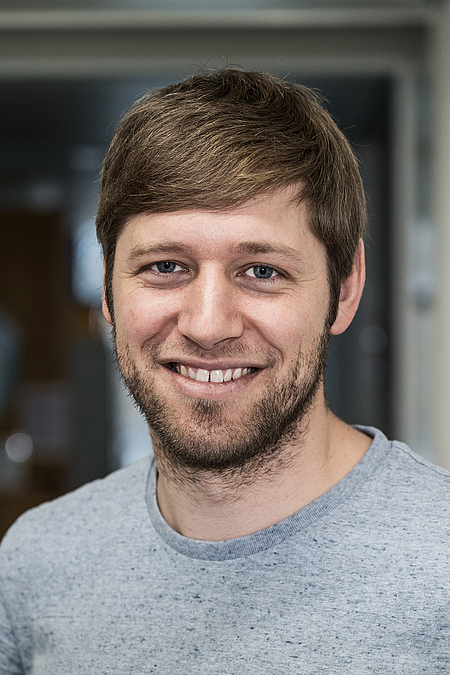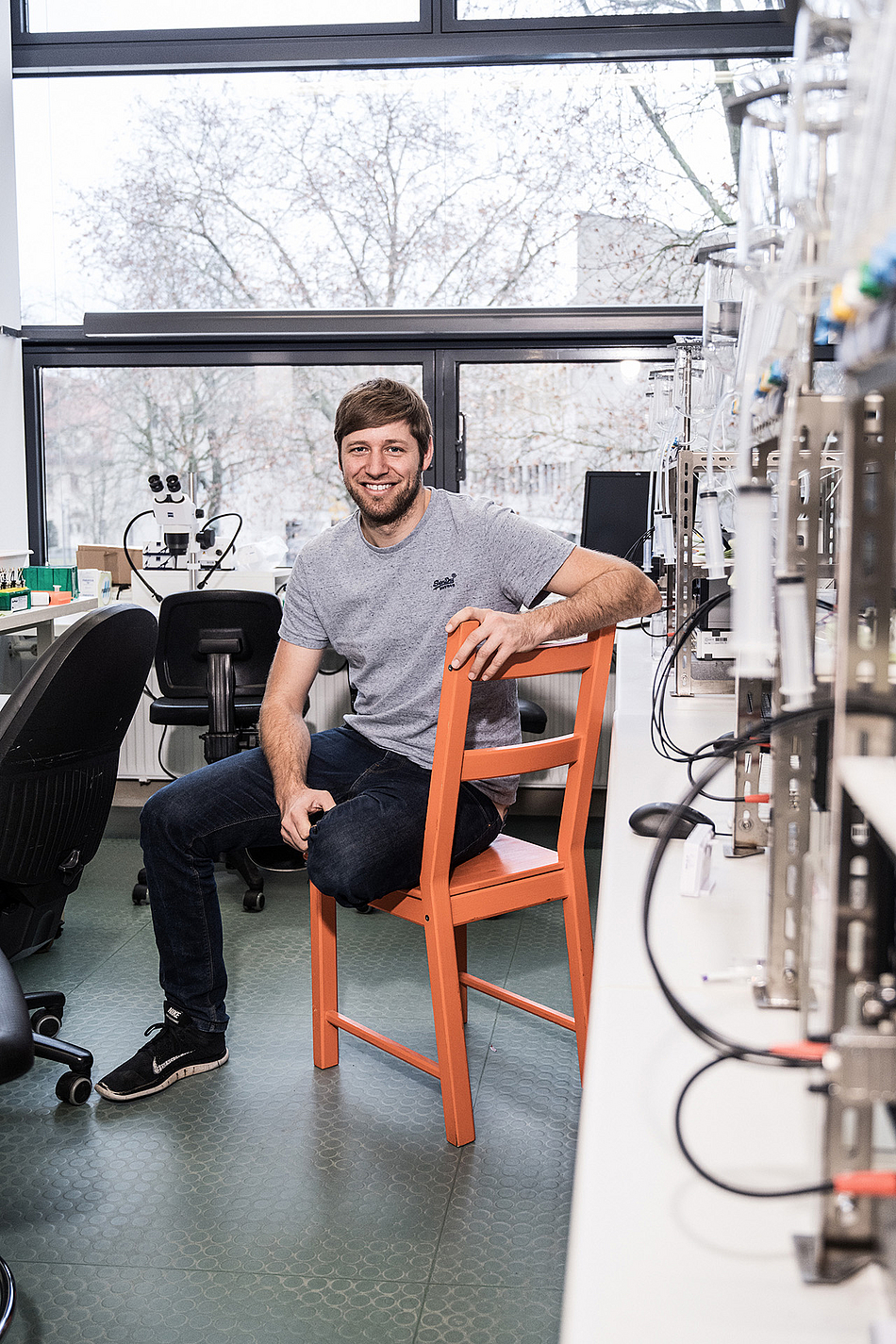In search of rare door-openers for young patients with cystic fibrosis
As a Clinician Scientist, Dr. Simon Gräber divides his time between patient care at the clinic and research in the lab. The future consultant in pediatric and adolescent medicine specialises in cystic fibrosis, also called “mucoviscidosis”, a rare hereditary metabolic disease which often already appears in childhood. The disease used to entail a short life expectancy. Meanwhile, there are some very good therapy options, though not for all patients equally. We talked with the Clinician Scientist, whose project is being funded by the Charité Foundation, about his research, his patients and, not least, about what motivates him at a personal level.
Dr. Gräber, in your research project you’re focused on the pharmacological modulation of rare CFTR mutations. What exactly does that mean?
The cause of cystic fibrosis lies in the mutations of a gene called the “CFTR” gene, which is short for “cystic fibrosis transmembrane conductance regulator”. There are about 2,000 different mutations of this gene. Some of them occur far more frequently than others. 90 percent of patients have common mutations. For these cases, medications have been developed that are an excellent help nowadays. However, 10 percent of patients have rare mutations. There are currently still no medications for this group, i.e. the rare cases. We’d like to help them with our research.
How exactly do you plan to help this smaller group of cystic fibrosis sufferers?
We’re developing a medication for this patient group that repairs a defective chloride channel which typically occurs in cystic fibrosis. Basically, you can imagine it as a door. The door has to be open for the mucus to be able to dissolve. However, in the case of these patients, the door is broken. It’s locked or jammed closed. The medication has to unlock and open the door, and keep it open. As there’s still no gene therapy for this, we’re working pharmacologically, i.e. with medications.
Cystic fibrosis is above all known as a disease that already appears in childhood. Who are your patients?
We do in fact treat a lot of children. In the past, families often had to embark on a long Odyssey through the health system until they got the right diagnosis for their sick child. So back then, the diagnosis was often a psychological relief for those concerned. Since 2016, we have comprehensive screening of all newborns in Germany. This is excellent, as it means you can detect cases earlier and start with treatments sooner. However, psychologically, it’s often more difficult for the families. They thought their child was healthy and suddenly they find out it has a rare hereditary disease. Here, it’s extremely important to communicate and provide information in a sensitive way. Medicine has made great advances over the past few years. In the past, children with this disease didn’t reach adulthood. Today, we have an average life expectancy of around 50. In addition, cystic fibrosis can also be caused by rare mutations which don’t make themselves felt until the age of 30, 40 or 50. So we take care of adult patients too.
What led you to begin researching this disease?
I already had an enthusiasm for pediatric and adolescent medicine during my studies. As chance would have it, it was sport that led me to cystic fibrosis research. I played lacrosse and there were a few colleagues on my team who were working in Professor Mall’s laboratory.

Funding program
BIH Charité Clinician Scientists
Funding period
2018 – 2020
Project title
Functional characterisation and pharmacological modulation of rare CFTR mutations
Research area
Pediatric and adolescent medicine, pneumology
Institution
Charité – Universitätsmedizin Berlin
Since 2018
Specialist training in pediatric and adolescent medicine and research assistant, Clinic for Pediatrics with a focus on pneumology, immunology and intensive care, Charité - Universitätsmedizin Berlin
2012 – 2018
Specialist training in pediatric and adolescent medicine and research assistant, University of Heidelberg
They were still looking for staff for a cystic fibrosis project – and that’s what led me to the topic of my doctoral thesis and to cystic fibrosis: from lacrosse to the lab, as it were.
The purpose of the Clinician Scientist Program initiated by the Charité Foundation is to guarantee that you can go on researching, parallel to patient care and the further training necessary to qualify as a specialist – through the protected times for science. Does this work out in your everyday routine?
The protected times for research are particularly valuable for me. A couple of years ago, I became a father. Your priorities change. The classic “research after working hours” no longer came into question for me, and I think you can only do qualitatively excellent research within the framework of such a program. You really need concentrated time for it. It’s actually impossible to achieve it by researching on the side. The work with patients is incredibly rewarding. You get direct feedback and it’s precisely that which is so important for research. This is why the Clinician Scientist Program is so valuable. It brings doctors, and the clinical view that’s often missing in the basic sciences, into research. This enables you to carry out much better research, which ultimately benefits the patients.
Where do you see the biggest differences between purely clinical work and free research?
One big difference that I perceive between clinical and scientific work lies in the error cultures. On a day at the clinic, you want and ought to get everything right. The important thing is to stick to certain guidelines and do your best to avoid mistakes. A failure at the clinic is always a personal failure too.
In the evening, you brood on what went wrong and on the fact that something like that is not supposed to happen. In research, it’s different. There, failing means making progress. You can learn, gain new insights and draw new energy from every failed experiment. If something doesn’t work in the lab, you try to gain something positive from it. At the clinic, that happens more rarely.
How do you relax from your demanding job?
When I’m not at the clinic or the lab, you’ll find me on the playgrounds of Berlin or cycling out to the countryside.
A playful question in conclusion: Which three people, living or dead, would you like to have an imaginary dinner with?
Colin Kaepernick. He’s an American quarterback who spoke out against racism and police violence, invented “taking the knee” and has been unable to find a job in the NFL since then.
Dr. Stephan Illing. He’s a pediatric pulmonologist in Stuttgart who has a lot of enthusiasm for the field and for the patients and is a very motivating person. I haven’t worked directly with him very much, but when you meet him at congresses, it’s very inspiring.
Professor Richard Boucher. He’s an acknowledged expert and the head of cystic fibrosis research at the University of North Carolina in Chapel Hill. I’ve already met him once, but I’d love to have an in-depth discussion with him some day.
June 2020 / Marie Hoffmann
